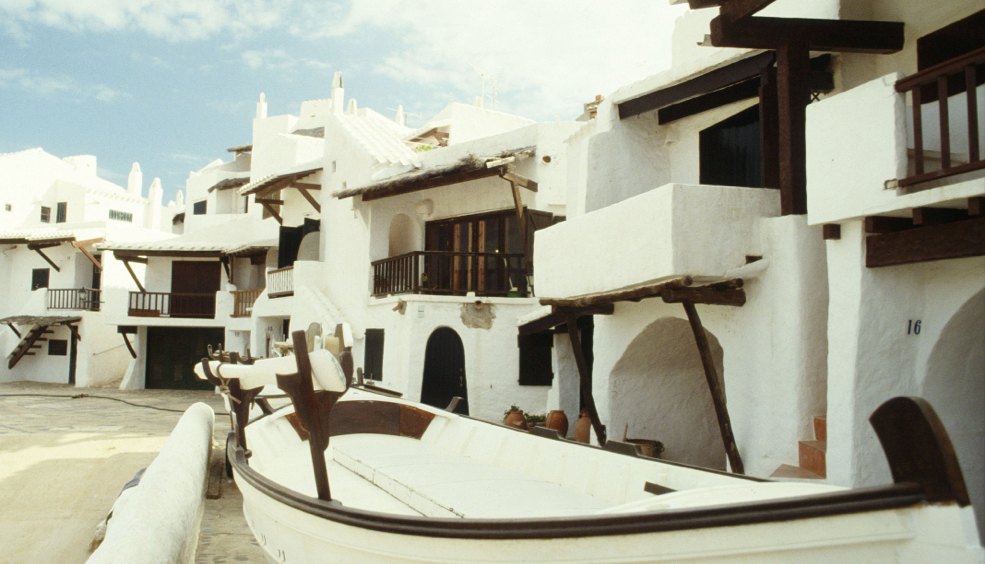The charm of fishing villages
Even the towns at the interior of Mallorca, like Valldemossa, Fonalutx or Biniaraix, are under the shelter of Tramuntana mountain range, are those which kept better the interesting traditions and costumes, by the shore there are little places that survived the urban growth.
Therefore, idyllic images of Mediterranean fishing villages have gradually disappeared as tourists arrived massively. However, there are still charming spots in Mallorca bays, keeping the essence. Visiting them is necessary in order to understand the cultural heritage of the island.
Es Jonquet
Next to Santa Catalina quarter, in Palma, and enclosed by Sant Matgí street, the border between both areas, there is Es Jonguet, one of the oldest neighborhoods in the city, which has conserved all the charm of a fishing quarter. This is a humble neighbourhood, with low-lying houses and irregular streets, rising proud under the mills (old flour mills) that welcome travellers arriving from the sea.
S'Estaca
Do not confuse this old fishing village, near Valldemossa, with the huge mansion that actor Michael Douglas owns in this area and is named the same. The village has about twenty old fishermen shelters where it seems that time has stopped. A magic place between Sa Foradada and Port de Valldemossa.
Porto Petro
Porto Petro is at the town of Santanyí, southeast of Mallorca. Even it’s not a fishermen port as it used to be, it has respected, surprisingly, all its original essence. There are not huge residential areas; only little stores and familiar houses. This is a place for people who want to relax in the nature, with many coves nearby. Closely, however, there are the real tourist areas, like the cove of Mondragó or Cala d'Or, which have a lively activity on summer nights.
Port des Canonge
Passing by Banyalbufar, southwest of Tramutana, the mountain range gets to the sea at Port des Canonge. To get here you have to follow a windy road to discover, at the end, the old houses that fishermen used as shelter and now are a little residential area, with the beauty intact. The quay and a nice beach made of gravel and boulders, make this spot a very quiet place.
Closely, you will find little coves or walk through pine forests following "Volta des General", a nice route that goes from Banyalbufar to Port de Canonge.
Porto Petro by Magnus Manske | Es Joquen by Chixoy | Port des Canonge by mallorcaesasitambien
Makes you want to go, right? Do it! Check out our prices here!
more infoCoruña Submits to St John
Greeting the arrival of summer is taken very seriously by the people of A Coruña. Indeed, the festivity of the Night of St John (San Xoán, in Galician) is celebrated extravagantly, with fire playing a major role in the form of myriad bonfires taking over the beaches, and magic rituals unfolding all over the city. The fiesta has grown ever more popular in recent years and in 2015 was designated an international Tourist Interest event. It is the perfect excuse for a getaway to A Coruña to spend a very special feast of St John.
While the big night is that of 23 June, the preceding week sees the city splashing out on a plethora of concerts, gastro events and children’s activities, although at the back of people’s minds is the Eve of St John on the 23rd, when the ancestral sun worship rituals take place.
“Sardiñadas”
The “sardiñadas” or sardine festival provides the centrepiece of the Festa de San Xoán. The city is impregnated with the characteristic smell at dinner time, what with sardine cook-offs organised by grass-root associations studding the streets and spilling over into the bars. The grilled sardines are usually eaten with broa (corn bread), which you should make a point of tasting. To round off the experience, be sure to have the local punch known as queimada to set you well on your way in this long, grand festival night.
Beach Bonfires
Fire is unquestionably the highlight of the Night of St John, and the beaches, where most of the celebrations are concentrated, become filled with light and charm. So, be sure to head for any of the beaches as night falls and set up your own bonfire, or else tag along with any of the numerous groups you will encounter on your way – they are certain to welcome you into the fold. You could always head for either Orzán or Riazor, where most people congregate or, if you are the sort that tends to avoid large crowds, we suggest you choose a smaller beach, like San Amaro or Las Lapas, or the tiny coves of Adormideras. The idea is to pick your perfect spot for spending the shortest night in the year.
The moment of maximum splendour is midnight, when the main effigy or Falla is lit on the beach of Riazor. This is preceded by fireworks which, together with the bonfires, fill the calm waters fringing the seaside promenade with light. Then starts a fiesta which is sure to see you through to daybreak, and the nocturnal events will be redolent with a host of purification rituals. The idea is to put all the bad things from the previous year behind you, in order to start afresh, or to simply have a great time on such a special night.
TExt by Turismo A Coruña
more infoSo much more than beaches: culture and cuisine in Menorca
There’s so much more to Menorca than just idyllic beaches, fishing villages and charming paths by the sea. The island offers amazing food and a busy cultural programme throughout the year.
more infoSHOPPING SPECIAL: 7 UNMISSABLE DESTINATIONS
London, Milan, Berlin, A Coruña, Paris, Barcelona and Stockholm are our favourite cities for shopping tourism. Essential destinations for shopaholics!
more info




